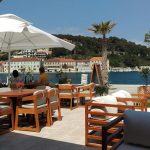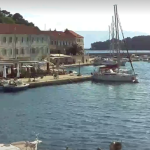As happens quite a lot these days on the ferry to or from Split and Stari Grad, I was approached by a local person with a suggestion for my blog. Life as a blogger certainly is easier when people know who are, and there have been some really excellent submissions recently, for which many thanks to all. This particular lady directed me to a website about Jelsa’s history and the contribution made to it by the town’s most influential son, one Niko Dubokovic. I had come across the website several years ago, but had forgotten what a trove of great material there is on the site, which is mostly in Croatian. She gave me permission to spread the word to a wider world, and so here is the first piece, already translated by Ms. Eco Hvar as it happens, on Jelsa and its sailing ships in the 19th century.
Jelsa is a charming little town situated midway along the northern coast of Hvar Island, known as the sunniest island on the Adriatic. It lies at the foot of a majestic hilly landscape which rises up to the south over the Vrh and Vratnik hills, with the Jelsa-Starigrad plain stretching out on the other side, to the west.
Jelsa is shielded from the Adriatic’s most unpleasant south wind, the “jugo”, whereas it is exposed to the north-easterly “bura”, which gives Jelsa its crystal-clear climate and creates spectacular high rolling seas in winter. Today it is hard for Jelsa’s residents and visitors to imagine what this idyllic little town was like 180 years ago at the beginning of the 19th century, reduced to one third of its inhabitants, wretchedly run-down, victim to floods and malaria, surrounded by swamps, and at the mercy of the force of the bura and the lashing waves from the open sea. It was as if the might of the sea and the land had conspired to hinder even the slightest revival for the remaining few inhabitants. However, after a short spell of total discouragement (in 1847 Jelsa even lost its town council for a brief while when it passed to Stari Grad) Jelsa suddenly turned to shipping development in the middle of the 19th century, even though it did not have the same shipping conditions as other ports in Dalmatia or even on the island. By the end of the 19th century Jelsa boasted the biggest sailing fleet in central Dalmatia.
As from 1830, and especially from 1848 on, under the new mayor Ivan Duboković Nadalini (1805-1872), Jelsa set about repairing and extending its harbour, at the same time as it was founding its own sailing fleet. In a short space of time Jelsa boasted one of the most beautiful ports in Dalmatia and a fleet which surpassed the tonnage of many others in Dalmatia, including several ships which were up to international commercial standards. For instance, according to available records, in 1884 Jelsa had 142 ships of 1550 tons, while Split had 152 of 1611 tons, and Stari Grad had only 92 ships of 950 tons.
Jelsa’s development as a whole, not just in the maritime field which is the subject of this article, is owed largely to the ship-owning Duboković Nadalini family, who were enterprising professional sea-captains as well as landowners, wine-producers and industrialists. Together with the unstinting efforts and labour of a whole generation of the then-inhabitants of Jelsa, they overcame seemingly insurmountable hurdles to make Jelsa into the most prosperous municipality of the Austro-Hungarian Empire by the end of the 19th century.
The Duboković family’s magnificent ships included eight ocean-going vessels, which sailed all the seas of the world, flying the Croatian tricolor from the mast from 1848. They sailed from the Atlantic Ocean and the Mediterranean Sea and the Black Sea.
They sailed from the Atlantic Ocean and the Mediterranean Sea to the Black Sea carrying local produce and goods for export such as salted fish, Brac stone and lime, and bringing back cheap grain and corn from Russia, Romania and America. This guaranteed that there was sufficient flour for bread, not only for Jelsa and Hvar Island, but also for the whole of central Dalmatia, probably for the first time in these parts. Wine was exported to France (Sète) and Italy, while to supply the needs and improve the quality of local winemaking sulphur was brought from Italy, copper sulphate pentahydrate (blue vitriol) from Venice and equipment from as far away as England. There was also local trading which supplied the population with various goods from the great ports of Trieste and Rijeka. The ocean-going sea captain Niko Duboković, son of Ivan (1834 – 1912), showed outstanding nautical skills while still very young (at 23), so much so that the Maritime Government in Trieste granted him a permit to educate sea-cadets on his ships.
The first Duboković ship sailed into Jelsa harbour in 1851, a square-sterned brig-schooner named “Marietta”, which was built in Korčula and had a capacity of 95 tons. Tasked with researching the possibilities for obtaining spices from the regions around the Indian Ocean, it sailed successfully for 20 years over the Mediterranean and Black Seas under the command of Mate Gamulin as a reconnaissance vessel for the much larger capacity sailing fleet. Sailing to Africa round the Cape of Good Hope, it went down with the whole crew near Zanzibar, having run into a coral reef in a storm near the port of Kismayo on the then little-known coast of Somalia. The captain was Vjenceslav Kaponi. It is interesting that the ship was sailing round Africa despite the fact that the Suez Canal was already open: this was probably because of the high cost of towing sailing ships through the canal. According to researches by Captain Lukin Dančević, the ship-owners’ intention was to obtain spices directly from source in Zanzibar, then to transport them in their ships to Aden, where they would be transferred to boats from the regular shipping lines to cross the Suez Canal in order to reach the Adriatic. Unfortunately this initiative, which was daring for its time, was unsuccessful.
In 1855 the 368-ton ocean-going brig “Genitor Nicolo” sailed into Jelsa. It was built in Korčula, and was the property of the same ship-owner. This boat too was among the Jelsan sailing ships which, along with other Dalmatian vessels, established links with the ports of the Black Sea, Greece and Turkey. The “Genitor Nicolo” was known in sailing circles for the achievements of its 23-year-old commander Captain Niko Duboković, who once quelled panic among his crew and training cadets during stormy weather on the Black Sea by playing the piano. That was in 1860, and we know the details from the account by the son of the ship’s bosun Vicko Ivanišević: the blue water was constantly flooding the deck. Vicko wanted to break the ship’s railings with a heavy mallet to help the water run off, but Captain Niko would not allow this, explaining that it would frighten the cadets and crew, and that he would calm them down. Then he went to his cabin and, leaving the door open, played the piano, while at the same time calmly giving out the necessary orders. (Later, due to his father’s ill-health, the young Duboković retired early from the navy to take over running the family properties.) The “Genitor N” was lost with its cargo and crew in the Bay of Biscay in 1865, on its way from Lisbon to Cardiff. The captain at the time was Frane Goić from Supetar.
The loss was quickly made up in the same year with the purchase of two big ships from England. One was the ocean-going 370-ton brig “Genitor Mose” (formerly the “Balmoral”), which was commanded by Piero Koludrović from Jelsa, and which sailed the whole world except for Australia. The other was the 524-ton ocean-going barque “Genitor Nicolo II” (formerly the “Humphrey Nelson”), named after the lost brig, which was under the command of the owner, Ante Duboković, brother of Captain Niko. Its sailing log is preserved in the Duboković archive in Jelsa. It often sailed the route between England and New York, and took on passengers, as it had cabins and all the necessary facilities, which was rare among our sailing ships. In 1871 the big ocean-going 220-ton brig-schooner “Marietta D” arrived, which sailed for another 20 years and was sold in Italy just before the end of the century. All these ships were armed with three cannon apiece to ward off pirates. The Duboković Nadalini Jelsan fleet reached its peak with the Barque “Ivan D”, which was unrivalled at the time. Built in Korčula in 1873, it had a capacity of 780 tons. For its time, compared to the size of ships generally, it was gigantic. It was registered for 17 years in the Jelsan harbour, but in fact never entered it because it was so big. It sailed from the Atlantic to the Mediterranean and Black Seas, and visited the ports of Canada, England, Portugal, Spain, France, Ireland, Greece, Asia Minor and America, as well as the mouth of the Danube.
Jelsa had other boats, schooners and two-masted ships known as ‘peligs’ belonging to this owner, while others owned boats which were of lesser capacity and significance, but which boasted very courageous crews for the impressive fishing fleet, as well as brilliant captains, most notable of whom were the six ocean-going captains from the Gamulin family. Possibly the most famous of them at that time was Antun Gamulin Moro, who became a commander at 27 and was co-owner of the schooner “Cosmo G” and the two-masted ‘pelig’ “Santa Maria della Salute”, among others.
Although very different in character, he and Captain Niko Duboković were friends, cousins and comrades-in-arms. Antun Gamulin Moro was a very handsome man, a life-long sailor, visionary, occasional writer, patriot and populist, known from Dalmatia to the Levant for his independent free-thinking, a lover of the good life and beautiful things, not to mention beautiful women – another fact for which he was well-known in the Levant. He was accepted warmly, especially among the Greek inhabitants of the Levantine ports, because he would sing songs of freedom from the Turks in Greek, accompanying himself on the traditional ‘gusle’ (a type of lyre).The respected populist Don Miho Pavlinović* wrote in his praise in a poetic epistle dedicated to Captain Niko Duboković:
” ..Moro pays heed to the honour meted to his uncle (Captain Niko)
Raises the tricolor in all corners of the world,
And spreads word of the Croatian people;
Expresses pride in his homeland,
And demonstrates Slav integrity to all;
So he is the Greeks’ favourite trader,
They open their Hellenic hearts to him,
As he awakens their national sentiments,
That longing for freedom for Crete.
A flock of ships would follow Moro
Who came from little Jelsa in the middle of Hvar…”
* (This period when Jelsa and its great shipping fleet were flourishing was also a time when national consciousness was developing through the People’s Party, which was led by Don Miho Pavlinovic.)
At the end of the 19th century the Jelsan sailing ships were dying off one after another. What has remained are the impressive witness accounts of the way these ships manoeuvred as they left the harbour under a favourable wind. The people of Jelsa and its surrounds would gather on the quayside to see each ship off and bid it farewell. With the north-westerly ‘maestral’ blowing, the crew on the yardarms would hoist the sails within the confines of the port, while taking their leave of their loved ones on shore or in small boats. The ships would raise their flags and glide out of the port under full sail, accompanied by 50 – 60 sailing fishing vessels. It is easy to imagine what a wonderful sight that must have been.
Jelsa’s shipping achieved enviably high levels by the end of the 19th century, ensuring it primacy relative to many other Dalmatian ports which had also developed seafaring..
Steamboat NADSteamboat Veljko
The new century brought a sudden change in Jelsa’s situation. Thus ended a famous period in our nautical tradition, its first great flourish in history, which demonstrated the diligence and capabilities of our people, and left a visible mark on the prosperity and culture of the region. Sadly, Jelsa, like the majority of the Dalmatian sea-ports, did not seize the moment when they should have followed the rest of the world in exchanging their sailing ships for steamboats. The new era was a time when capital investment rose rapidly, to be concentrated at the end of the 19th century in the flourishing ports of Austro-Hungary and Dubrovnik. Seafaring was once more reduced to local cabotage. The Duboković Nadalini family founded a company called NAD in Rijeka, and invested in 2 steamships, the “NAD” and “Veljko”.
Lukrecija Benkovic Dubokovic
Translated by Vivian Grisogono
For more on the fascinating history of Jelsa, visit www.nikodubokovic.com










